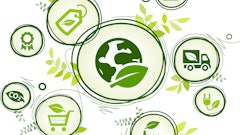
At its Q4 2023 product launch event, Apple announced a first-of-its-kind product: a supposedly entirely carbon-neutral Apple Watch. According to the company, the product was enabled, in part, by its “supply chain expertise.”
Whether or not Apple’s claims are valid or valuable is secondary to the burgeoning reality for many businesses: carbon neutrality is critical, as new regulations, consumer demands and internal pressures are raising the stakes for making supply chains more sustainable.
Supply chain sustainability, the integration of environmentally and socially responsible practices into supply chain management, aims to reduce the environmental and social impact of the supply chain while also creating long-term value for all stakeholders.
It’s an increasingly important priority to boardrooms and decision-makers. Accenture notes that nearly half of CEOs consider supply chain responsibility part of their sustainability strategy.
It’s also easier said than done. Up to 70% of a company's emissions can come from its supply chain.
However, change is possible.
Sustainability initiatives aren’t contingent on significant up-front investments. Instead, there are practical ways to get started that can yield immediate operational efficiencies, enhancements and cost savings that make sustainability a sustainable practice for supply chain and logistics entities.
Here are three steps any supply chain or logistics entity can take over the course of 2024 to make their supply chain more sustainable -- and profitable -- than ever before.
#1 Define Objectives & Measure What Matters
Supply chain sustainability means different things to different people. One company’s sustainable supply chain is another’s logistical nightmare.
That’s why an effective supply chain sustainability initiative starts with defining the most important objectives and measuring their beginning status and change over time. Key objectives include:
- Implementing sustainable business strategies: Companies make sustainability a central part of their business strategy when integrating sustainable practices into their daily operations.
- Embedding sustainable data into business processes and networks: Companies are data-driven when they collect and analyze sustainability-related data. Therefore, track greenhouse gas emissions, resource usage and waste reduction metrics.
- Managing carbon and climate exposure across the supply chain: Companies can assess their carbon footprint and take steps to reduce emissions.
- Prioritizing people across the supply chain: Companies make their supply chains more sustainable by ensuring fair labor practices, ethical sourcing and safe working conditions.
Achieving a sustainable supply chain requires collaboration, continuous improvement and a long-term perspective.
To measure these objectives effectively, companies will set clear goals, integrate sustainable practices, collect and analyze relevant data, and adapt their practices accordingly.
#2 Rapidly Model & Re-Model to Account for Changes
While organizations have often viewed supply chain network design models primarily for long-term planning, new technology means they can also be used for quick, sprinted analysis. Enabling more continuous network optimization.
Artificial intelligence (AI) and machine learning (ML) technologies make data-driven sustainability possible.
These technologies help companies maximize their expansive data sets, getting the best information to guide their current sustainability strategies. What’s more, AI enables brands to employ a digital supply chain twin, a virtual representation of a supply chain designed to reflect a physical reality that assists in analyzing different scenarios.
With the right tools and technology, modeling and continuous improvement are possible. Additionally, performing “what if” scenario modeling for alternative options and balance between objectives can foster the best sustainability outcomes. Long-term sustainability projects with higher upfront costs and longer payback periods demand rigorous data analysis to evaluate potential pain points, trade-offs and other potential pitfalls.
For example, constructing a new distribution center or reworking a network can produce higher short-term costs for long-term savings. Shuttering an old plant to build a new one requires a large investment but pays off with increased productivity, efficiency and lower costs in the long run. Similarly, while nearshoring requires upfront work and can carry higher production costs, it offers significant savings on fuel and transportation.
Modeling and remodeling these scenarios empower decision-makers to leverage artificial models to inform real-world decisions.
#3 Achieve Supply Chain Transparency
You can’t fix what you can’t see.
Visibility is key to supply chain sustainability. It allows companies to measure and monitor various touchpoints, including vendors, facilities and processes, that undermine sustainability outcomes.
Full visibility and product traceability from source to consumer make it possible to verify and substantiate ethical sourcing practices.
It also supports compliance mandates.
Achieving visibility into tier 3 compliance and beyond, along with the capability to manage all assessments and audits about working conditions such as those evaluated by SLCP, Better Work, ABVTEX and environmental impact assessments like HIGG FEM, fosters a more robust, more sustainable supply chain.
This comprehensive approach ensures that various aspects of sustainability, including labor practices and environmental stewardship, are closely monitored and enhanced across the supply chain, leading to improved overall performance and sustainability outcomes.
Strategic Sustainability is Achievable
The upside of more sustainable supply chains benefits companies, and many organizations are now integrating sustainability into the supply chain process and mindset, improving resiliency and predictability and reducing risk and variability in planning.
Companies that successfully make their supply chain more sustainable sell more products, elevate their reputation, reduce compliance and regulatory risks, and save money.
It’s a win-win-win-win scenario that requires effective implementation to be successful.


























